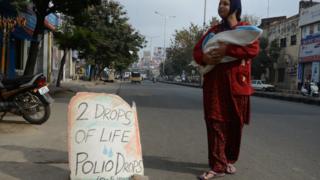The southern Indian state of Telangana declared a "high alert'' for polio after an active strain of the virus was found in samples of sewage water in the state capital, Hyderabad. India was declared polio free in 2014 and Paarul Ratra spoke to some health officials to understand how such threats are neutralised.
What causes strains of the polio virus to be found in sewage?
According to Dr Rajesh Singh, who is the regional health officer for the northern Indian city of Allahabad, one major factor for the re-emergence of the polio virus in sewage is the fact that many children are immunised against polio through oral vaccination. "When the vaccine is given through the mouth, the liquid that gets dissolved and passed on in the form of stool accumulates in the sewage system. The virus in that vaccine becomes a stronger and more resistant strain," he said. Dr Pradeep Haldar, the deputy chairman of the national immunisation programme, said, "People will continue to suffer as long as the oral vaccine is around. It tends to circulate for a long time. It has been happening, it never stopped and it won't stop unless, and until, we stop using the oral vaccine". Internal migration and water pollution are also likely causes.

A woman walks to a polio vaccine camp with her baby
How do health officials respond to such a situation?
"When it was found that Hyderabad might be at risk of polio, an environmental sample was taken immediately - and the report proving that it was in fact polio came within a week on 7 June. If there's a case spreading in the environment, all the concerned areas are scanned and action is taken," Dr Haldar said. The scanning phase has three aspects - immunisation coverage, testing of all lame children in case they carry a virus and polio surveillance. "If these three parameters are clear, then we can confidently say that the risk is low because our surveillance methods are of a high standard. "Even if one child out of 2,000 is affected, then the risk would be 5% higher or if even one child is missed out during the surveillance, the risk would be high. But we are confident that this is not the case," he said. Dr Singh added that everyone within a five kilometre radius is vaccinated as soon as possible to mitigate the chances of the virus spreading. Officials in Hyderabad plan to vaccinate more than 300,000 children, starting on 28 June.
Is there a strong possibility that polio can resurface in India?
According to Dr Singh, the chances of polio resurfacing are very low. "If the child is tracked over the first year and if the vaccine is given on time, it can be completely eradicated," he said. However Dr Haldar said that given the problems with oral vaccinations, there are bound to be at least between 100 and 1,000 low-risk carriers of polio, as vaccinations against the "wild" polio virus - which occurs naturally - were stopped in 2011 after no new cases of the disease were reported.
http://www.bbc.co.uk/news/world-asia-india-36549189






 Reply With Quote
Reply With Quote